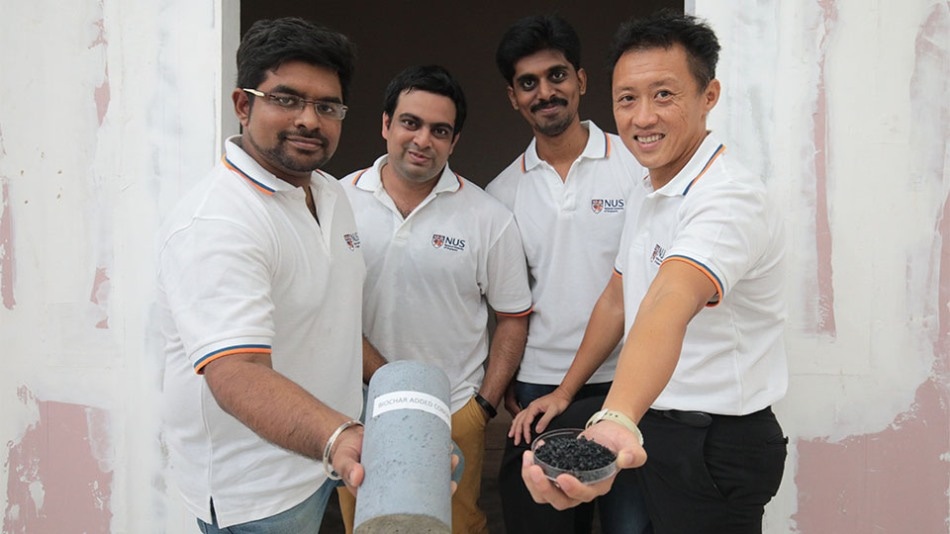Apr 16 2018
A novel, environmental-friendly technique that strengthens building structures has been developed by researchers from the National University of Singapore (NUS). The innovative method combines biochar, which is recycled from sawdust, into cement and enhances the water tightness (impermeability) and strength of concrete and mortar. It provides an alternative way to use the large amounts of wood waste generated in Singapore.
 The research team led by Associate Professor Kua Harn Wei (first person from the right) has developed the novel approach of using biochar made from recycled wood waste to enhance concrete structures. (Image credit: NUS)
The research team led by Associate Professor Kua Harn Wei (first person from the right) has developed the novel approach of using biochar made from recycled wood waste to enhance concrete structures. (Image credit: NUS)
Furniture factories produce wood waste that accounts for a large portion of waste produced in Singapore. In fact, over 530,000 tons of wood waste was produced in 2016 alone, which mostly contained saw dust. Instead of disposing or incinerating wood waste in landfills, it can be recycled to make biochar—a carbon-rich, porous material that can reliably absorb and retain water.
Since biochar has good water absorption and retention properties, the agricultural industry extensively uses this material as soil amendment to enhance crop yield. The researchers successfully used biochar to considerably enhance the permeability and mechanical properties of mortar and concrete, thus further expanding the application of this material. The team included Associate Professor Kua Harn Wei, his PhD student, Mr Souradeep Gupta, and their team members from the Department of Building at NUS School of Design and Environment.
Just adding a minute amount of dry biochar powder to the concrete or mortar mixture improves the performance of mortar and concrete. The added biochar changes the conditions of the concrete and mortar mixture and improves its curing and hardening properties.
During the course of the experiments, the team discovered that early impermeability and strength of the concrete and mortar mixture can improve by as much as 50% and 20%, respectively. This means the formwork can be removed early, thus saving considerably amounts of construction time and cost. In addition, biochar itself ‘locks in’ carbon in its structure, which would otherwise be discharged into the atmosphere by incineration of biomass or decay. Therefore, the application of biochar technology in concrete construction is indeed a unique way to store carbon in buildings and at the same time promote recycling of wood waste and strengthen building structures.
This is a simple and affordable strategy to enhance our building structures, particularly in Singapore, where water leakage from rain and water pipes are common problems. At the same time, we are putting the large amount of wood waste generated in Singapore into good use. Close to 50 kilograms of wood waste can be utilised for every tonne of concrete fabricated. We typically require 0.5 cubic metre of concrete for every square metre of floor area built in Singapore. This translates to around six tonnes of wood waste being recycled to build a typical 4-room HDB unit with a floor area of 100 square metres.
Associate Professor Kua
In order to investigate the commercialization of this technology, the NUS researchers are presently in discussion with a local company and they are also tapping this technology to come up with other high-performance cement composites that can be used in a variety of applications.